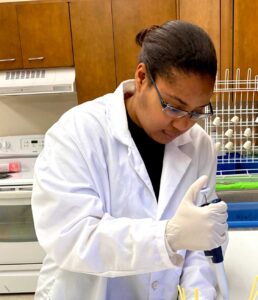Meet Food Technology Major Alexis
Your First Choice

I was born in New Orleans, but I basically grew up in Slidell which is an hour away. Originally I came to McNeese because I was interested in becoming a dietician, and I was looking for colleges that weren’t too far away. McNeese was only three hours away, and I thought that the dietician program was really good so I decided to go here. Therein started my journey!
I was in the dietetics program at McNeese, and one of the classes I took was introduction to food science, and originally I thought it was like another nutrition class, but it kind of gave you an idea what food science is — it was cool to be able to look behind the scenes and learn how food products are made and tested and packaged and how they get to market. I found that interesting and I continued to talk to my professor and my now advisor Dr. Tankgham, and then I was eventually like, “You know what? I think I want to switch to food technology.”
I graduate this spring, and it’s been great. For my food experience class, you can do an internship or create a food product and basically go through the process from start to finish. Food technology has many different areas like safety and packaging, but I really like the sensory aspect. I love trying different things and evaluating new products and evaluating what the consumer likes, so I decided to make a food product. Previously I did a short research with Dr. Tankgham on which lactic acid bacteria would be better for fermentation of yogurt. So when this year she was like, “What would you like to do for your product?” and I said it would be cool to piggyback off of our previous research.
Food technology and food science are trying to figure out how we can make more things with plant based sources, because the population is increasing and they’re trying to find more sustainable sources to feed everyone, and it’s a great alternative for people who can’t have dairy. So I said, “Why don’t I make a plant based yogurt?” I really want to add more variety for the consumer and give them more options in the supermarket that they can choose from — right now if you go to the store and you can find plant based yogurts, but usually they’re made out of soy, coconut, almond or cashew. I’ve tried some myself and they’re pretty interesting. The texture was looser, but it can depend on brand. I decided to do macadamia nut because I didn’t see a lot of that, and I love them, they’re my favorite nut – they’re buttery, creamy and slightly sweet, so I thought they would be perfect. Coconut is popular because you want something creamy, which coconut has because of high fat content, and that’s what I was also looking for when I chose macadamia nut.
I was able to do the sensory evaluation where I make the product and allow people to try it. So I made the base and added flavors and allowed people to try it. Right now, I actually am in the midst of gathering all of my preliminary data, but from talking to students the one that they tend to like the most is the one flavored with roselle, which is my favorite too. The color is really nice and the flavor is nice, and then I use honey to sweeten them. In terms of the microbial content, and the physicochemical stuff and water activity, I’m still putting all of that together.
All of my professors have been very encouraging. I showed Mrs. Moore, and Mrs. Geneva my product and got Mrs. Moore to taste it and she loved it – she allowed me to talk about it when the class and pass out some surveys and allowed me to get some preliminary data on what people thought about macadamia nut yogurt, like, “Would you like to see this on the shelves? Would you like to buy it?” They’re excited for me and have been there to help me through.